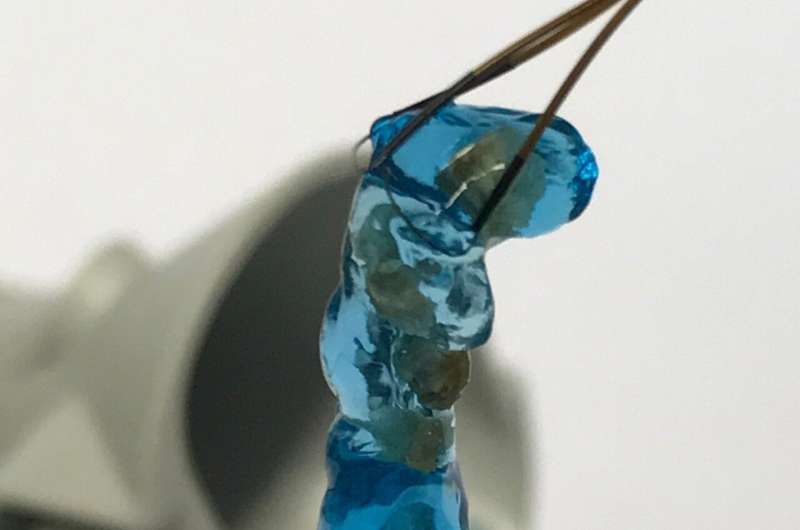Using hydrogel to remove kidney stone fragments


Kidney stones are often removed via an endoscopic procedure. If a stone is too large, the urologists break it into pieces using a laser. The larger pieces can be removed with a grasping instrument, but this is not possible for the smaller fragments—instead, they remain in the kidney in the hope that they will leave the body naturally. In the future, doctors will be able to remove even the smallest of stone fragments from the kidney during endoscopy using a hydrogel. This biocompatible 2-component system was developed by Purenum GmbH, a spin-off of the Fraunhofer Institute for Manufacturing Technology and Advanced Materials IFAM.
Kidney stones are a common condition around the world. According to the German health insurance company AOK, ten percent of Germans will experience a kidney stone at some point in their lives. The size of the stones varies—at their worst, they can be as large as a walnut. The risk factors that can lead to the formation of a kidney stone include an unbalanced diet, a lack of exercise and insufficient fluid intake.
Kidney stones can be treated with medication or with minimally invasive therapies; as the technical possibilities continue to evolve, urologists are opting more and more frequently for endoscopic procedures. The endoscope is inserted into the kidney via the urinary tract in order to locate the stones and remove them in a targeted manner. If the kidney stone is larger than five millimeters—i.e., larger than the natural urinary tract—it must be broken into pieces using a laser. These pieces vary in size: The larger ones can be removed with a grasping instrument, but the smaller ones are too tiny to be grasped. Within a few months, the fragments that remain in the kidney can grow into a large stone and cause complications once again.
Purenum GmbH decided to tackle this problem. Manfred Peschka and Prof. Ingo Grunwald founded the company as a spin-off of Fraunhofer IFAM in Bremen back in December 2017. By participating in the GO-Bio funding program for biotechnology startups offered by the German Federal Ministry of Education and Research (BMBF), they were able to secure the funding they needed to launch their company successfully.
Biocompatible hydrogel encapsulates kidney stone fragments in seconds
The product that the two researchers have developed to combat the tiny stone fragments is a hydrogel made from biocompatible materials. It consists of two liquid components that have been dyed blue and yellow to ensure a good color contrast. This allows the surgeon to control dispensing in an extremely precise manner. The blue component is applied first, then flows around and wets the stone fragments. Following this, the yellow component is added. Application is extremely straightforward as the two components do not need to be mixed. Within a few seconds, the addition of the yellow component produces a gel that is solid enough to hold the small stone fragments inside. It is also elastic enough to be grasped with a grasping instrument and pulled through narrow channels (such as an endoscope). This makes it easy for the surgeon to pull the gel containing the stone fragments out of the kidney via the endoscope. After the operation, it can be dissolved easily in order to analyze the stones. “We intend to launch the gel on the German market in the second quarter of this year under the name mediNiK-basic,” explains Manfred Peschka, CEO of Purenum GmbH.
100% stone removal possible with mediNiK
“The term ‘stone-free’ is not precisely defined—there are various definitions. And there have not been any systematic studies conducted among patients to provide information about the size of the stones retrieved during operations,” says Prof. Ingo Grunwald, CTO at Purenum. He continues: “To that end, we are currently conducting a study at five different locations. Once it has been completed, this study will underpin our promise that, with mediNiK, we can remove more small stone fragments than would be possible without the use of our hydrogel.” The product is also attracting international interest, with Purenum GmbH receiving inquiries from all over the world. “There are no comparable products out there at the moment—mediNiK is a world first in the field of urology,” says Prof. Ingo Grunwald, a biologist. His colleague Manfred Peschka adds: “Our success is due in no small part to Fraunhofer IFAM. Without the exceptional support of Institute Director Prof. Bernd Mayer, Purenum GmbH would not exist.”
Adhesive to replace screws and plates
Source: Read Full Article